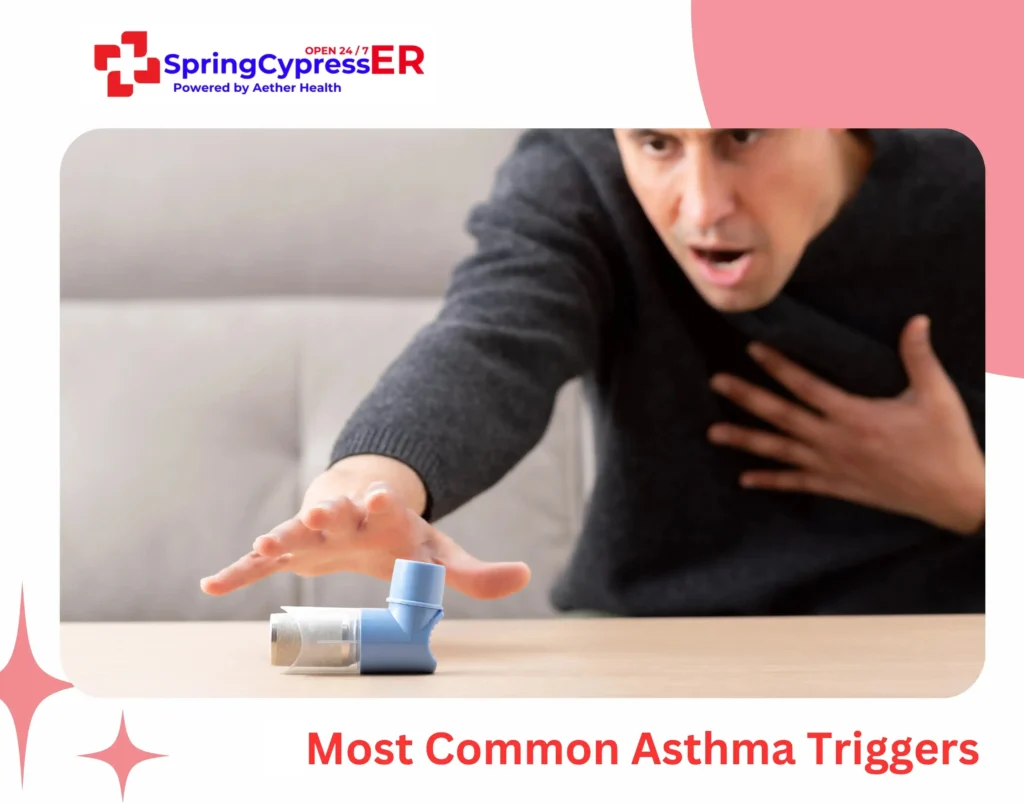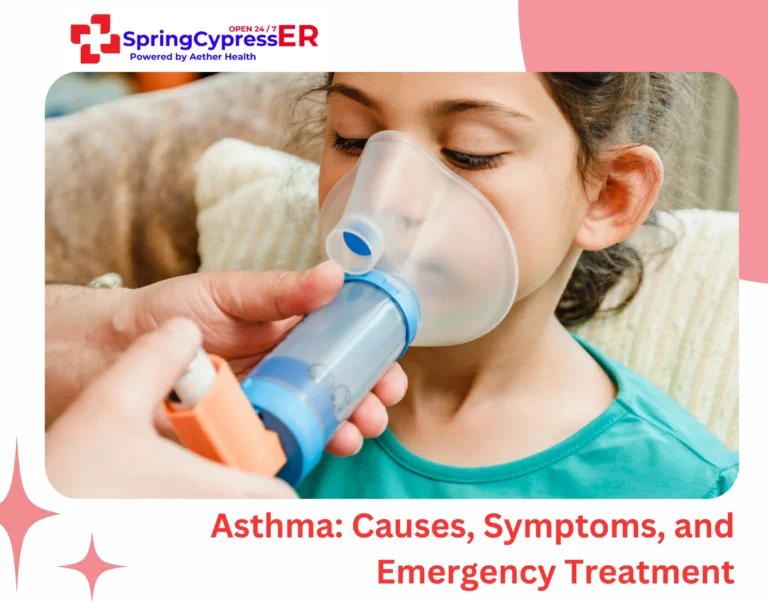Asthma affects 1 in 12 people in the U.S.¹ Yes, it’s that common! But how do you live a normal life when something as basic as breathing feels like a struggle? You miss out on things you love, like hiking, sports, even a good night’s sleep.
The coughing and wheezing keep you up, and you hate asking people to adjust for you. The thing is, you have to adjust to it. But that doesn’t mean it has to control your life.
Asthma has no cure, but if you understand the causes, symptoms, and emergency treatments, you can manage it. We at Spring Cypress ER want you to breathe easy, without fear. So we decided to put together this simple asthma guide. When you’re done reading, you’ll know how to prevent asthma attacks and live a healthy life.
What Is Asthma?

Asthma is a long-term condition that causes breathing problems. The airways in your lungs swell up, narrow, and sometimes produce extra mucus. This combo makes it tough for air to move in and out of the airways.
There’s no cure, but with the right treatment, most people manage just fine. Of course, asthma isn’t the same for everyone. Based on how severe it is and how often symptoms show up, asthma is usually grouped into four categories:
- Intermittent Asthma: Mildest type, symptoms show up less than twice a week
- Mild Persistent Asthma: Symptoms happen a few times a week but not every day
- Moderate Persistent Asthma: Symptoms happen daily
- Severe Persistent Asthma: Symptoms are constant, throughout the day and night
If you’re curious about what causes asthma in the first place, let’s talk about it.
Causes of Asthma Onset
Asthma can start at any age, but it often begins in childhood. Researchers believe it develops due to a mix of genetic, environmental, and developmental factors.
- Genetics: Asthma often runs in families. If your parents or close family members have asthma or allergies, there’s a good chance you may get it too.
- Overactive Immune System: People with allergies (such as atopy) have an exaggerated immune response.It overreacts to harmless things like dust or pollen, which leads to the swelling and trouble breathing we call asthma.
- Early Childhood Factors: Severe viral infections during infancy can increase the risk of developing asthma and breathing problems. Limited exposure to certain microbes during childhood may hinder proper immune system development, a concept known as the hygiene hypothesis.
- Conditions During Pregnancy: If the mother smokes, breathes in a lot of pollution while pregnant, it can affect lung and immune system development in the baby.
- Premature Birth: Babies born prematurely or with low birth weight may have underdeveloped lungs, increasing the risk of asthma later in life.
Symptoms of Asthma
Asthma symptoms can vary from mild to severe and may come and go. Common symptoms include:
- Shortness of breath
- Wheezing – A whistling sound when you breathe
- A feeling of pressure in the chest
- Coughing that often worse at night
- Increased mucus production
What Is an Asthma Attack?
An asthma attack is a sudden worsening of asthma symptoms. During an attack, the muscles around the airways tighten and swell. It feels like you’re breathing through a straw. A severe asthma attack is a life-threatening condition that needs immediate emergency attention. In addition to asthma symptoms, the signs of an asthma attack include:
- Rapid, shallow breathing
- Coughing that doesn’t stop
- Difficulty speaking due to breathlessness
- Pale or bluish lips and fingernails (a sign of low oxygen)
6 Most Common Asthma Triggers

Things that make your asthma worse or cause an asthma attack are asthma triggers (they don’t cause asthma in the first place). Everyone’s asthma triggers are different, but common ones include:
1. Allergens
- Pollen
- Dust mites
- Mold
- Pet dander
2. Irritants
- Cigarette smoke
- Air pollution
- Strong odors or fumes
3. Respiratory Infections
- COVID-19
- Flu
- RSV
- Common cold
- Croup
- Pneumonia
4. Weather Conditions
- Sudden changes in temperature, cold air, or high humidity
- Windy conditions that stir up pollens
- Heavy rain makes trees and grasses produce more pollen
- Extreme heat
- Smoky air from wildfires
- Ground-level ozone can be a strong asthma trigger in places where heat and sunlight combine with pollutants
5. Strong Emotions
Anxiety, laughter, or crying can sometimes trigger asthma attacks.
6. Physical Activity
It triggers exercise-induced asthma.
Emergency Treatment for Asthma
Don’t panic when hit by an asthma attack. It only makes things worse. The following practices can help you get better:
- Take 2-4 puffs of your quick-relief inhaler (like albuterol). If nothing changes after 20 minutes, take another round.
- Sit up straight. Lying down makes breathing harder.
- Loosen your clothes to help you breathe.
- If the inhaler isn’t working, reach the emergency room for the fastest asthma management.
Steps of Asthma Attack Treatment in the Emergency Room

Here’s how we control your asthma at our Spring Cypress emergency room:
- Rapid Assessment: The expert team at ER Spring Cypress checks your oxygen levels and vital signs to determine the severity of the asthma attack.
- Oxygen Therapy: If we see signs of low oxygen levels, we put you on supplemental oxygen.
- Quick-Relief Medicines: Short-term bronchodilators like albuterol or Ipratropium quickly open airways. We give it through rescue inhalers or nebulizers to reach your lungs quickly.
- Anti-inflammatory Treatment: When initial treatments don’t provide enough relief, we may give additional medications to reduce airway inflammation.
- Advanced Interventions: For severe symptoms that don’t respond to initial treatment, we can provide additional emergency interventions while arranging transfer if needed.
- Continuous Monitoring: We closely track your vital signs, oxygen levels, and response to treatment throughout your emergency care.
- Coordinated Transfer: For cases requiring extended care or specialized treatment, we quickly arrange seamless transfer to appropriate hospital facilities, maintaining constant care throughout the process.
- Asthma Action Plan: Once you’re stabilized, the doctor will provide an asthma action plan. It includes your asthma triggers, how often you have symptoms, and what medications to take. This plan helps you and your loved one prevent attacks, manage symptoms, and know what to do in an emergency.
Seek Emergency Asthma Care in Spring Cypress
Don’t let asthma control your life. By knowing your triggers, staying on top of your symptoms, and having a plan in place, you can live a life like others.
If you ever feel like you can’t catch your breath or things get out of hand, call 911 or visit us. We’re here, day or night, ready to help you breathe easy again.
FAQs
1. How do I know if my asthma is getting worse?
If you’re using your rescue inhaler more than twice a week, wake up in the middle of the night, or find it harder to do normal activities, it’s time to check in with your doctor.
2. How can I manage asthma in the long term?
Take prescribed medications consistently, avoid known triggers as much as possible, get a vaccine against respiratory infections, and get regular ER checkups to monitor your asthma. These tips keep asthma flare-ups at bay.




